The New York Times Has Missed the Silver-Gold Story
This post The New York Times Has Missed the Silver-Gold Story appeared first on Daily Reckoning.
I read the New York Times… but only so that you don’t have to. Often as not, it’s painful to peruse the raw sophistry and unreflective bias in many of the news articles, let alone the poison-pen editorial page, but still I power through. Fortunately, though, the world offers many other news sources which help me figure out what’s happening across the globe.
And much is happening. So much, in fact, that I’m not entirely sure where to begin (but yes, I’ll comment; see discussion below). And when I’m not sure how to approach a vast mix of events, my default position is to begin with a look at the price of silver and gold, which together tend to distill quite a few earthly matters into a couple of easily understandable numbers.
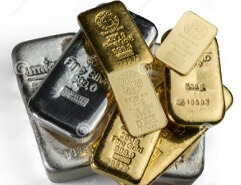
And in the case of silver and gold, those numbers are going up-up-up, counterpart to other things that are going down-down-down.
Precious Metals Up ➡️ Dollar Down
Let’s begin with silver, which closed yesterday (Monday, Oct. 6) at $48.38 per ounce, up about $19.00 since the beginning of 2025. Here’s the chart:
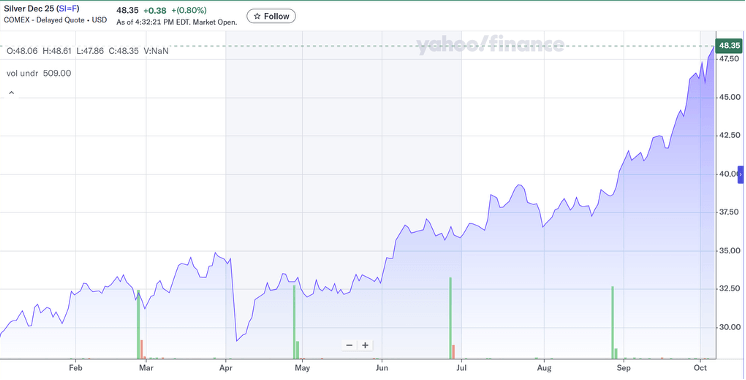
Price of silver since Jan. 1, 2025. Yahoo/finance.
Or try this; look back a quarter century to year 2000. Here’s that chart:
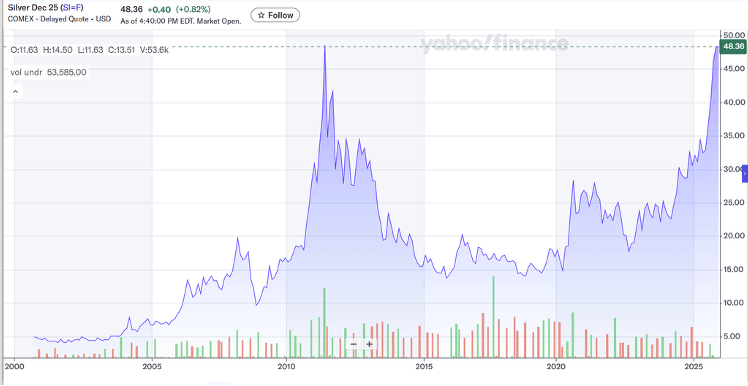
Price of silver since year 2000. Yahoo/finance.
Way back when the world was supposed to end due to Y2K (remember that?), an ounce of silver would set you back by about $4.70. Or do math, and in the past 25 years the silver price has increased over ten-fold, which reflects a distinct decline in purchasing power of the dollar.
Of note from the long-term silver chart, the post-2010 runup was a monetary quirk in the wake of the Great Financial Crash of 2008-09. In terms of supply and demand, there was “enough” silver, in the sense that mine output exceeded total demand from industry, jewelry, and silver-stackers. And for reasons of classical economics – namely, more than sufficient supply – the silver price faded in 2011-12 but still landed in a generally upward trend over time.
Today? Things are different. There’s vastly more industrial silver demand than before, while the white metal now offers increased levels of allure in terms of monetary safety. Meanwhile, mine output of silver, plus recycling, no longer meets global demand, in no small measure because China-China-China uses so much primary metal in its massive output of electronics, as well as its dominant position on the global supply chain for solar panels.
The point is that silver shines right now, and this feature isn’t fading by any metric. Price support comes from booming industry use, with the addition of relatively new levels of monetary demand, plus the fact that global output can’t deliver the ounces.
Takeaway: buy silver and silver miners, even at current levels because the downside is protected and upside is blue sky.
Now, let’s look at gold. It closed yesterday at an astonishing $3,984 per ounce, up about $1,330 since the beginning of 2025. Here’s the chart:
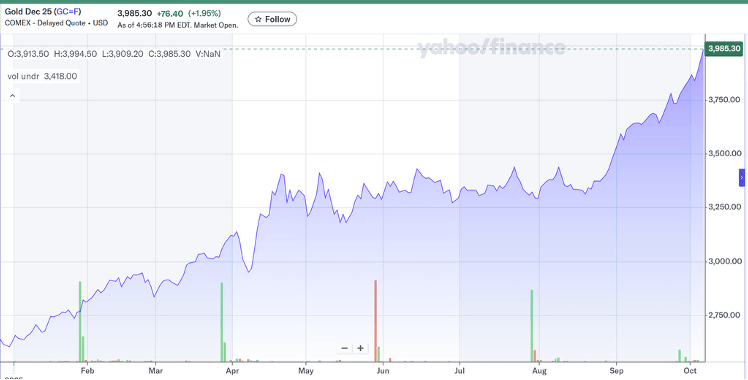
Price of gold since Jan. 1, 2025. Yahoo/finance.
And as with silver, above, let’s look back a quarter century to year 2000:
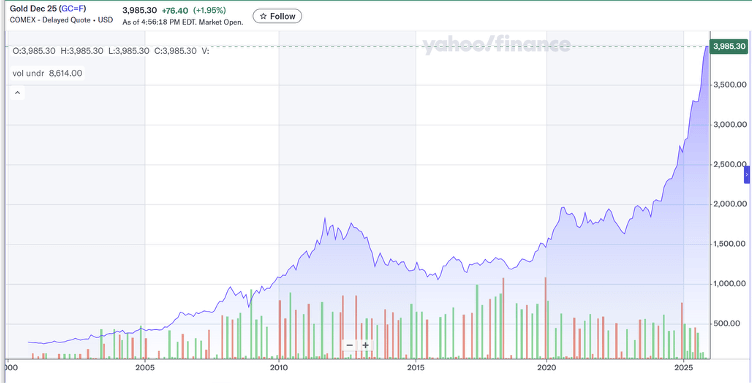
Price of gold since year 2000. Yahoo/finance.
Again, similar to the case with silver, way back in Y2K an ounce of gold traded as low as $250 (seriously; that number is NOT a typo). And do that math! Because in 25 years the gold price has increased about 16-fold, reflective of that above-noted, distinct decline in purchasing power of the dollar.
Takeaway: buy gold and gold miners, even at current levels because the downside is protected and upside is blue sky.
In fact, the price of gold has moved up so much, so rapidly that even the New York Times has noticed:
“President Trump’s decorators aren’t the only ones bringing gold back into fashion. Investors, money managers and central banks across the world have piled into gold this year, pushing its price about 50 percent higher and setting a series of records in the process. Gold is approaching $4,000 per ounce for the first time.”
Oh, that predictable, sanctimonious newspaper! The staff and editors just can’t help themselves. First, nobody is “pushing” the price of gold higher. No, the rise in price for gold reflects a clear, evident, obvious, long-term fade in the value of dollars.
Meanwhile, it’s as if the Times applies an AI auto-correct feature to all of its news articles. That is, any coverage of anything – even gold – must begin by bashing President Trump. Still, this article in the Times makes for a good place to transition to other angles on what’s happening out there.
Characteristically, the Times Misses the Story
Here’s more from the Times, which refers to “analysts” who attribute “the recent rise in gold prices to demand from investors looking to shift away from U.S. assets at a time of political upheaval and uncertainty, highlighted by the government shutdown.”
Oh, c’mon, man. The government shutdown is all of a week old, and it could end in an afternoon if only a few Democrat Senators signed onto a short-term bill to fund the government. Yes, it’s that easy.
And in the past week, the price of gold has risen by what… about $100? But the Times wants its readers to think that gold near $4,000 is somehow due to the shutdown. Argh! Look at the charts above, and ask where these people have been for the past 25 years.
And then there’s this gem of a paragraph in the Times coverage of the rising gold price:
“Gold has also attracted buyers because other traditional havens, like the dollar and U.S. government bonds, have lost some of their allure. The Federal Reserve is expected to continue cutting interest rates, moves that could continue to weaken the dollar, which has already slumped roughly 10 percent this year. Worries over ballooning debts and deficits have cast a cloud over America’s creditworthiness”
Sorry, guys… But if you seek insight into either the history or fate of the dollar, or high-level issues with bonds, the Fed, interest rates, deficits and debts, and general U.S. creditworthiness, the Times is not your go-to crystal ball.
For the edification of anyone whose worldview has been shaped by exposure to the New York Times, much of the world has been de-dollarizing for any number of years. Certainly, nations across the world have shed dollars since the Biden administration weaponized the U.S. currency against Russia in 2022, after the outbreak of hostilities in Ukraine.
In the charts above, note when the recent rocket ride, upward profile for silver-gold prices began; in about late-2022, as U.S. and Western sanctions contra Russia went into high gear. Quickly, the world figured out that trusting the U.S. and its mercurial politics, and holding large numbers of U.S. dollars and/or bonds, had become a high-risk proposition. And now, the fact is that one sees open disdain for the dollar on a global scale.
Meanwhile, the Fed kept interest rates near-zero, and mathematically negative in terms of net-return, for about a decade after the Crash of 2008-09, in company with quantitative easing (QE) that flooded dollars into circulation far in excess of underlying economic output and growth. Hence, for the past 15 years (and more), we’ve lived with continuous inflation, as evidenced by the basic, persistent rise in silver-gold prices, coupled with declining dollar purchasing power.
As for federal deficits and national debt, that’s a feature, not a bug within the current U.S. system of governance. For some bizarre reason, federal law and procedure mandates a steady increase in budget baselines across the entire spending complex. And President Trump’s efforts to cut that spending, “drain the swamp,” or whatever else you call it have been modest at best.
While we’re on the subject, U.S. creditworthiness has long been problematic. Indeed, it’s black letter bankruptcy law that inability timely to pay one’s debts is the foundation of insolvency; and an inability to pay debts on time is the very definition of the word “insolvent,” a description that fits the U.S. government like a fine glove.
It’s not exactly a state secret that the federal government doesn’t take in enough revenue to meet its obligations. This has been the case for 50 and more years, with the exception of a couple years of accounting gimmicks back in the 1990s. And the only thing that allows the U.S. government to pay its bills is the dynamic duo of Treasury and Fed.
Together, the Treasury-Fed juggle so-called “money creation” by monetizing the country’s debt, now in the range of $37 trillion on the official books, with another $120 trillion or so hiding in the background as unallocated future obligations. And the cost of doing business this way is now up and over $1 trillion per year in interest; I’ve seen a number like $1.7 trillion for the upcoming fiscal year.
And yet (and not for the first time, to put it kindly), the New York Times missed this entire story when discussing the moves in silver-gold. To be blunt, the Times is in a frenzy to pin the blame for rising precious metal prices onto recent events, in essence the return of Trump to the newly gilded White House. It’s such a pathetic way to view the world…
Back to the Beginning
At the beginning of this note, I wrote that there’s so much going on that I wasn’t entirely sure where to start, so I kicked off by looking at silver and gold prices. My point was that the rising prices for silver and gold embody much that is going on; going on badly for the dollar, for savers, for Americans who are outside of the precious metals trade.
Begin with long-term inflation. It’s fair to say that many people have no particular idea about what the Fed does, or how it leads to inflation. That is, most people just note the rising prices for food, housing, utilities, health care, education, and so much else.
It’s also fair to say that most Americans don’t dwell on the constant, yearly federal spending deficits, nor the astronomically growing size and scope of the national debt, let alone the implications for the future value of dollars. And it’s not as if conventional media like the New York Times helps foster wide understanding.
And if you care about preserving long-term wealth, you cannot be comforted by gridlock in governance, such as what we see now with the ongoing federal shutdown; although to be clear, the Treasury takes in immense sums of revenue every month, but pays it all out and more in terms of outlays (beginning with that aforesaid interest on the debt!).
Which brings us to an idea that explains what’s happening with rising silver-gold prices, and the simultaneous decline in value of dollars. We’re witness to what’s called a “debasement trade.” That is, across the world, governments, banks, businesses and smart-money people are converting their dollars into hard assets like precious metals, or other “real” things like minerals in the ground, mining plays, or energy investments.
Governments, banks, businesses and smart-money people are defensive. They’re de-risking. The general level of trust in America is declining. We see wealth exiting from dollars for higher levels of security in tangible things that have no counterparty, or at least lower risk. And in this regard, the New York Times just plain missed the story of a generation, if not a lifetime.
Takeaway: use dollars to buy hard assets, or risk being left behind when it all transforms into something else and you’re not in on it.
That’s all for now. Thank you for subscribing and reading.
The post The New York Times Has Missed the Silver-Gold Story appeared first on Daily Reckoning.
This story originally appeared in the Daily Reckoning
Source: https://dailyreckoning.com/the-new-york-times-has-missed-the-silver-gold-story/
Anyone can join.
Anyone can contribute.
Anyone can become informed about their world.
"United We Stand" Click Here To Create Your Personal Citizen Journalist Account Today, Be Sure To Invite Your Friends.
Before It’s News® is a community of individuals who report on what’s going on around them, from all around the world. Anyone can join. Anyone can contribute. Anyone can become informed about their world. "United We Stand" Click Here To Create Your Personal Citizen Journalist Account Today, Be Sure To Invite Your Friends.
LION'S MANE PRODUCT
Try Our Lion’s Mane WHOLE MIND Nootropic Blend 60 Capsules
Mushrooms are having a moment. One fabulous fungus in particular, lion’s mane, may help improve memory, depression and anxiety symptoms. They are also an excellent source of nutrients that show promise as a therapy for dementia, and other neurodegenerative diseases. If you’re living with anxiety or depression, you may be curious about all the therapy options out there — including the natural ones.Our Lion’s Mane WHOLE MIND Nootropic Blend has been formulated to utilize the potency of Lion’s mane but also include the benefits of four other Highly Beneficial Mushrooms. Synergistically, they work together to Build your health through improving cognitive function and immunity regardless of your age. Our Nootropic not only improves your Cognitive Function and Activates your Immune System, but it benefits growth of Essential Gut Flora, further enhancing your Vitality.
Our Formula includes: Lion’s Mane Mushrooms which Increase Brain Power through nerve growth, lessen anxiety, reduce depression, and improve concentration. Its an excellent adaptogen, promotes sleep and improves immunity. Shiitake Mushrooms which Fight cancer cells and infectious disease, boost the immune system, promotes brain function, and serves as a source of B vitamins. Maitake Mushrooms which regulate blood sugar levels of diabetics, reduce hypertension and boosts the immune system. Reishi Mushrooms which Fight inflammation, liver disease, fatigue, tumor growth and cancer. They Improve skin disorders and soothes digestive problems, stomach ulcers and leaky gut syndrome. Chaga Mushrooms which have anti-aging effects, boost immune function, improve stamina and athletic performance, even act as a natural aphrodisiac, fighting diabetes and improving liver function. Try Our Lion’s Mane WHOLE MIND Nootropic Blend 60 Capsules Today. Be 100% Satisfied or Receive a Full Money Back Guarantee. Order Yours Today by Following This Link.






